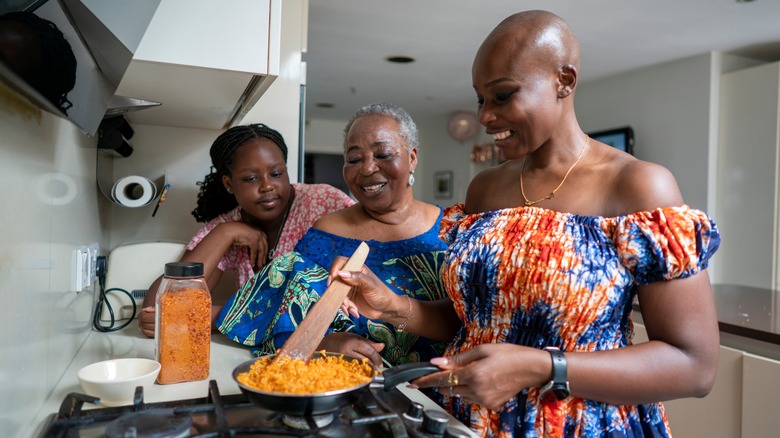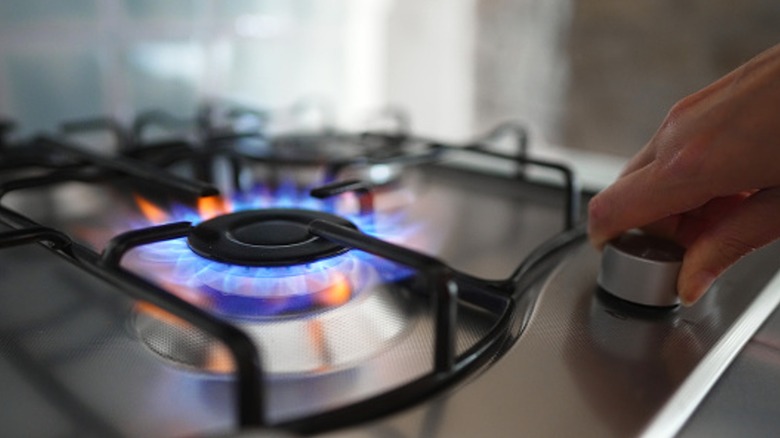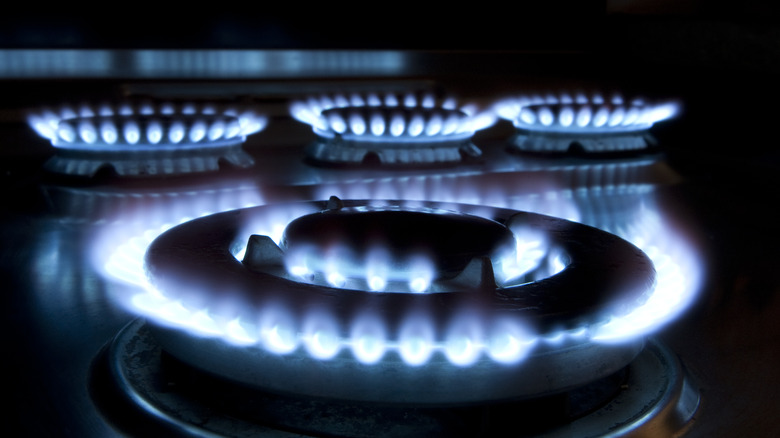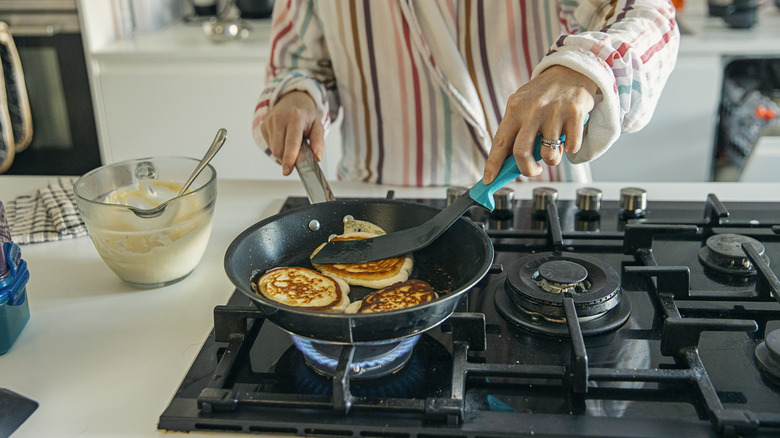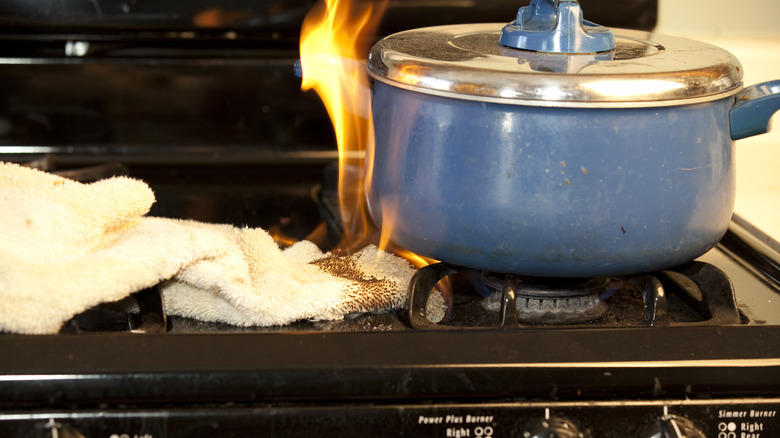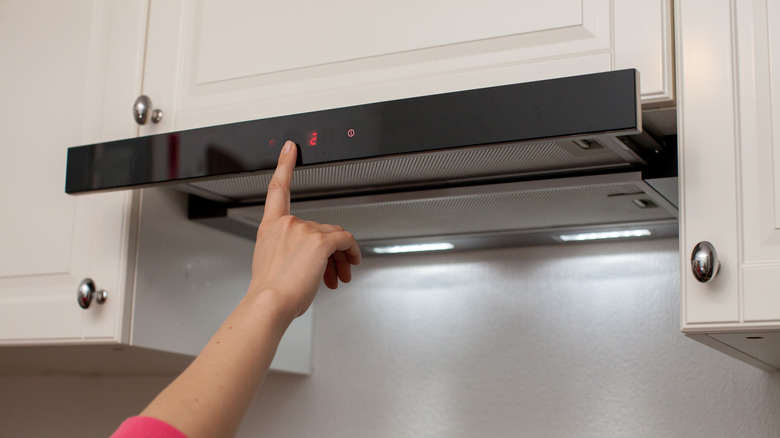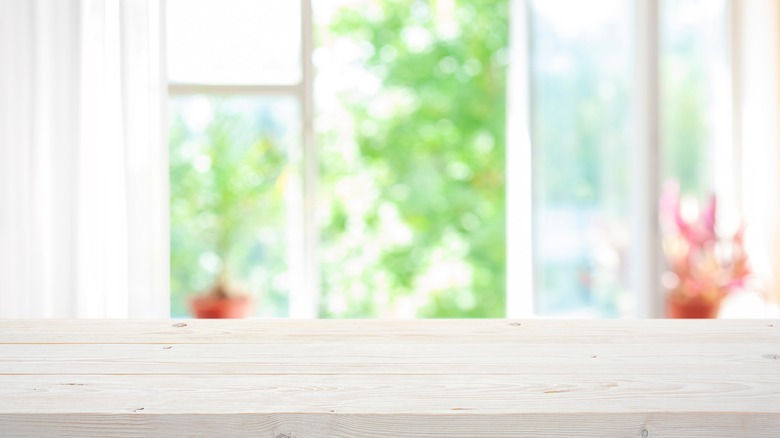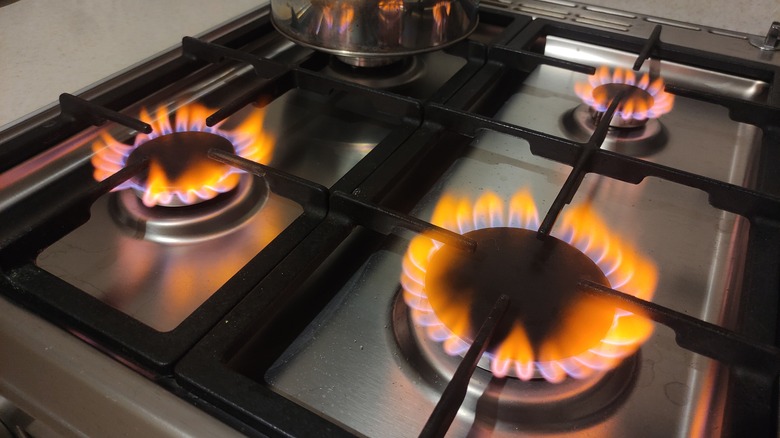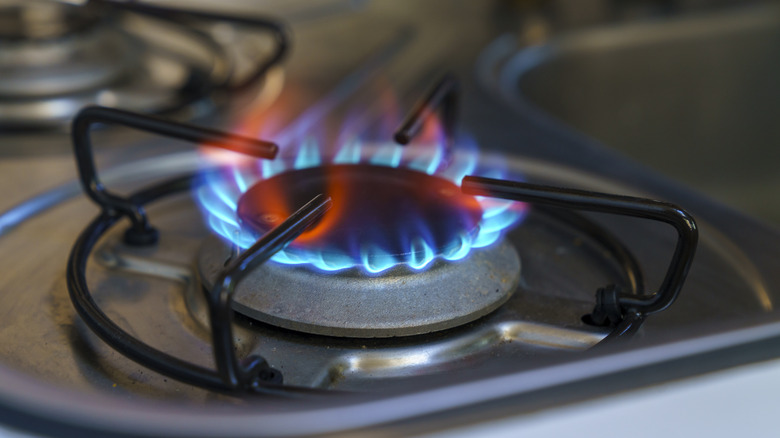Chefs Reveal The Biggest Mistakes People Make When Using A Gas Stovetop
We may receive a commission on purchases made from links.
There are several benefits associated with cooking on a gas stove. For one, because you're cooking over an open flame, the burner gets hot immediately instead of needing time to preheat when using an electric stove. Moreover, seeing the flame offers a greater sense of control than relying solely on the dial on an electric stove. Plus, the natural gas or propane (fuels) that power gas stoves typically cost less than electricity, helping users keep their utility bills lower. However, cooking on a gas stove is not as straightforward as one may think, despite all these benefits.
Unfortunately, several mistakes can be made when cooking over a gas stove. These mistakes can have dire consequences. Some may cause your food to turn out under or overcooked. Others could negatively impact the flavor of the finished dish. Still, other outcomes could have serious health or safety implications.
And so, learning what not to do when cooking over a gas stove is crucial. We reached out to two chefs – Galen Zamarra, co-founder of Galen Hospitality Group, and Jem Mantiri, founder, recipe developer, and food blogger at The Fruity Jem — to help us learn more about some common mistakes people make when cooking with gas — and what users should do instead.
Not setting the heat to an appropriate level
Knowing how to control a gas stove's flame — and therefore the heat output — is essential if you want to avoid making a mistake when cooking an omelet, simmering sauce, or searing meat. Jem Mantiri, food blogger at The Fruity Jem, shares that people tend to be impatient when cooking, which can cause them to turn the flame up too high. "High flames can burn ingredients, often leaving them scorched outside and undercooked inside. This can also make sauces dry up quickly, resulting in dry food," she explains. Instead, Mantiri recommends starting with the heat and flame at a medium level. Then, once your food starts cooking, she says to slowly adjust the intensity of the heat.
Galen Zamarra, co-founder of Galen Hospitality Group, highlights the benefits of using a lid when cooking to improve how well foods cook without cranking the flame up too much. He explains, "Liquids boil significantly quicker when you have a lid. You can control a simmer with a lid, which allows you to use less gas." Moreover, as Zamarra notes, covering foods you're cooking will help produce more steam and pressure inside the pot while also locking in heat. With this combination, your foods will cook evenly (and more quickly) without getting burnt on the outside.
Choosing a burner that is too small or too large
You've likely noticed that the burners on a gas stove are not the same size. This is an important design element that you shouldn't overlook when deciding where to place a pot or pan when preparing a recipe. Chef Galen Zamarra cautions against choosing a burner that is either too large or too small. If the burner is too big for the saucepan or saucier (which are not the same) you're cooking in, the flames will come out over the pan's sides. Zamarra explains, "The sides of the pan burn because that metal is very thin compared to the bottom, so your food, even a thin layer, will burn and can leave bad flavors in the dish." The pan is also subject to flares bursting up around the food when oil on the side catches alight. Zamarra adds, "This creates a petrol-type smell in your food and can really be awful."
Conversely, placing a large pan or stockpot on a small burner is not a good idea. Zamarra shares that if the burner isn't large enough, it won't deliver sufficient heat to cook your food properly. Food will take longer than necessary to finish cooking or may not cook properly. He also notes, "Small flames also result in uneven cooking; a sauce may have a small ring which burns in the center."
Overlooking the position of the flame
Beyond the burner size and the size of the flame, you should also pay close attention to how the pot is positioned over the flame. In many cases, you will want to make sure that the flame is centered beneath the pan you're cooking in. Otherwise, Jem Mantiri, founder, recipe developer, and food blogger at The Fruity Jem, explains "one side will cook faster than the other, resulting in unevenly cooked dishes."
However, this isn't a hard and fast rule, and there may be times when you don't want to perfectly center your cookware over the flame. "When cooking a sauce or stew, something that will simmer slowly for a long time, you can place the pot off center from the flame. This can be helpful if your burner doesn't go low enough and simmers too quickly," says Galen Zamarra, co-founder of Galen Hospitality Group. As you're watching your dish simmer, consider adding cornstarch to create a thicker slurry for stews.
Leaving flammable materials too close to the stove
Gas stoves cook food using an open flame. This is one of the appeals of this type of appliance, as users can see and more easily control the heat that they're cooking over. However, the open flame also makes cooking on a gas stove potentially dangerous. "Flammable materials can represent a hazard when being used or near a flame. Oven mitts and towels can catch on fire much easier than with an electric stove," says chef Galen Zamarra.
Additionally, take care when cooking with oils and other flammable ingredients over a gas stove. "If you are looking to flambé a dish it can be easier to ignite with a gas stove- an electric stove would require a lighter to ignite the dish- however, it can also be more dangerous if say, too much alcohol was spilled into the dish and ignited accidentally," explains Zamarra. Leave plenty of clearance space around the stove to prevent an accident.
Failing to turn on the exhaust fan
When cooking on your gas stove, don't make the mistake of leaving the exhaust fan off. As Jem Mantiri, founder of The Fruity Jem, explains, "Cooking on a gas stove releases smoke, steam, grease particles, and, most importantly, combustion products. Forgetting to turn on the exhaust fan means that these pollutants accumulate in the kitchen, affecting air quality and can be potentially harmful to health." Inhaling these pollutants could cause issues with your respiratory system or cardiovascular system. It might even increase your risk of developing certain forms of cancer. Similarly, you can take other measures to further improve the circulation of air in the kitchen. Mantiri recommends opening a kitchen window to improve the flow of air.
While the Consumer Product Safety Commission is not using this finding to call for getting rid of all gas stoves, they are looking for solutions that will limit the emissions and risks they pose to indoor air quality. For this reason, it's worth noting that some of your gas stove's burners are safer to use than others. When possible, use the back burners when cooking over a gas stove. Because of their placement, the exhaust fan will capture more of the pollutants released.
Cooking right next to an open window
With all of this talk about pollutants, you might look for additional ways to improve the flow of air through your kitchen when cooking over a gas stove. While opening a window can help improve air circulation, if the window is too close to the stove, it could actually lead to dire consequences. Galen Zamarra, co-founder of Galen Hospitality Group, warns, "An open window [can] cause the wind to blow out the flame. This can lead to gas leaks, or at a minimum, your food stops cooking, and you don't notice it." Finding out that your sauce hasn't been cooking will be frustrating, but the true danger of the flame getting extinguished by an open window lies in the accumulation of gas in the space. If too much gas accumulates without you being able to address it, an explosion could occur.
Due to this risk, building codes in most jurisdictions require at least 12 inches of space between a stove and a window. In addition to minimizing the chance of the hazard outlined by Zamarra, such clearance can also ensure that an accidental stove fire does not jump from the cooktop to the flammable curtains that are likely to be hanging on the window.
Not properly cleaning and maintaining the stove
Cleaning and regular maintenance are key if you want your gas stove to function properly and safely. Jem Mantiri, founder, recipe developer, and food blogger at The Fruity Jem, explains that residue from food or cleaning products can create a clog in the burner of a gas stove. She recommends regularly clearing the burners to remove food particles or other residues. Many pantry staples can help you clean your kitchen and gas stove, such as baking soda. You can also purchase commercial gas stove cleaners, like the Weiman Gas Range Cleaner and Degreaser, if you'd prefer a ready-made product. Gas stove grates are also easy to clean in the dishwasher. Beyond keeping the burners clean, Mantiri notes the importance of "[scheduling] an annual gas line inspection by a professional, especially when your gas line is quite old." Gas line inspections can catch blockages, faulty parts, or other conditions that could turn hazardous.
One thing that can clue you into a problem with your gas stove is the size or color of the flame. "If the flames are uneven, too large and discolored yellow/orange, for example, something is wrong and generally the burner is clogged and dirty," says Galen Zamarra, co-founder of Galen Hospitality Group. If something looks off, he recommends disassembling and cleaning the burners thoroughly. After air drying fully, you can put everything back together and check for that tight blue flame that indicates the stove is functioning as it should. If the problem persists, call a professional before continuing to use your appliance.
Leaving the flame unattended
Avoid leaving the flame unattended when cooking on a gas stove. "A single distraction while cooking or multitasking can lead to burned food, a smoky kitchen, or even a fire hazard," cautions Jem Mantiri, founder of The Fruity Jem. It's important to stay vigilant and avoid walking too far from the stove — and certainly to avoid leaving the house with the stove on. "If you need to step away, turn off the flame and relight it when you're ready to continue. Another option is to set multiple timers so you won't forget," Mantiri recommends. Consider an easy-to-set (and read) digital timer, such as the Antonki kitchen timer.
Forgetfulness can also be problematic when cooking on a gas stove. "Sometimes, people would also bring the heat to its lowest setting once the cooking is almost done, but they forget to turn it off. This is dangerous as this can cause fire hazards," warns Mantiri.
If you have a gas stove, it may also be tempting to use it to heat your home in the event of a power outage. However, this, too, is not safe. Beyond the fire hazard that leaving the flame unattended creates, improper use also has the potential to cause carbon monoxide poisoning or asphyxiation.
